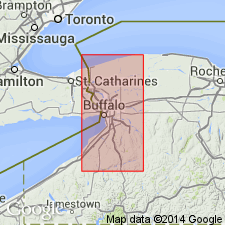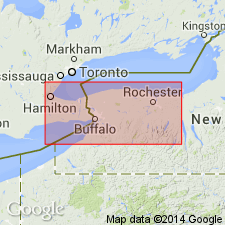
- Usage in publication:
-
- Eramosa Dolomite
- Modifications:
-
- Overview
- AAPG geologic province:
-
- Appalachian basin
Summary:
Lockport in this report is considered Late Silurian following Rickard (1975) as the NY Geological Survey does not recognize Middle Silurian as does the USGS. The revisions to the Lockport nomenclature discussed in this report will be formally proposed by C.E. Brett in a larger study of the Niagaran Series. The Lockport Group is divided into the (ascending) Gasport Limestone, the Goat Island Dolomite, the Eramosa Dolomite, and the Guelph Dolomite. According to authors, use of the name Eramosa has become confused in the past century. As revised by Brett and others, the Eramosa Dolomite immediately overlies beds in western NY previously designated as Eramosa by Zenger (1965), but which are regarded here as the Vinemount Member of the Goat Island Dolomite. As redefined, the Eramosa, consistent with Canadian usage, is a tripartite massive-flaggy-massive unit that contains several distinctive marker beds. Lower and upper members are characterized by massive-bedded to biostromal, fine grainstones containing corals. The middle member of the Eramosa is flaggy and contains large, loaf-shaped stromatolitic, thrombolitic, and favositid coral mounds. Unit ranges in thickness from 13.7 to 16.8 m. The Gasport includes the Gothic Hill and Pekin Members, and the Goat Island includes the Niagara Falls, Ancaster, and Vinemount Members. [Though three of the authors of this report (Tepper, Kappel, and Yager) are USGS scientists, the nomenclature used here has not been officially accepted for use by the USGS.]
Source: GNU records (USGS DDS-6; Reston GNULEX).

- Usage in publication:
-
- Eramosa Dolomite*
- Modifications:
-
- Revised
- Redescribed
- Dominant lithology:
-
- Dolomite
- AAPG geologic province:
-
- Appalachian basin
Summary:
The Eramosa Dolomite of the Lockport Group is revised to include lower interval formerly called the Oak Orchard Dolomite of the Lockport Group or the Oak Orchard Member of the Lockport Formation by Zenger (1965) and an upper interval formerly assigned to the Guelph Dolomite. The Oak Orchard is proposed for abandonment herein. The revised Eramosa consists of massive, pale brownish-weathering, vuggy, commonly biostromal dolomite with intervals of sparsely fossiliferous, medium-bedded, flaggy-weathering, brownish-gray, bituminous dolomite and stromatolite bioherms. Formation can be divided into six informal units. Unit A is a 7 to 8 foot thick, massive, biostromal dolomite characterized by thickets of ramose tabulate coral and abundant white chert nodules. Unit B is a 13 to 20 foot thick, fine-grained, sparsely fossiliferous and bituminous dolomite that weathers medium-bedded to flaggy. Unit C consists of tabulate coral biostromes (similar to unit A) and masses of stromatolites; unit is massive or thick-bedded, brownish-weathering, saccroidal dolomite with large vugs. Unit D is a 16.8 foot thick flaggy-weathering, dark brownish-gray, nonfossiliferous, saccroidal dolomite with a middle massive interval that contains coral. Unit E is a 1- to 2-foot-thick marker bed of light-gray, laminar, stromatolitic dolomite. Unit F consists of 7.4 ft of medium-grained, olive-gray dolomite that locally contains scattered oolites and corals (similar to unit D). Thickness of the Eramosa is 38 to 50 ft. Well exposed in the Niagara River Gorge on old sewage treatment plant access road in Niagara Falls, Niagara Co., NY. Unconformably overlies the Goat Island Dolomite and underlies the Guelph Dolomite, both of the Lockport Group. The Eramosa is of Late Silurian (Ludlovian) age based on conodonts. [Report uses Early and Late Silurian time scale of Harland and others (1982).]
Source: GNU records (USGS DDS-6; Reston GNULEX).
For more information, please contact Nancy Stamm, Geologic Names Committee Secretary.
Asterisk (*) indicates published by U.S. Geological Survey authors.
"No current usage" (†) implies that a name has been abandoned or has fallen into disuse. Former usage and, if known, replacement name given in parentheses ( ).
Slash (/) indicates name conflicts with nomenclatural guidelines (CSN, 1933; ACSN, 1961, 1970; NACSN, 1983, 2005, 2021). May be explained within brackets ([ ]).

